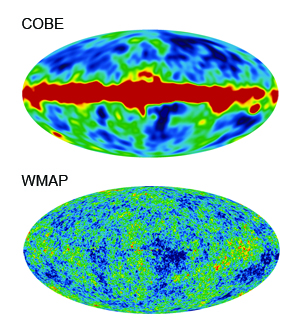The Lumpy Universe
The Universe that we see today is very lumpy. There are planets, stars, galaxies, and clusters of galaxies. Yet when we look at the afterglow from the Big Bang, we see an incredibly smooth glow across the sky. So how did the matter in the Universe get to be so lumpy after starting out so smooth?
Astronomers generally agree that gravity shaped the evolution of the lumps we see in the Universe today. The force of gravity between different chunks of matter caused the chunks to pull together into one body, and then that body pulled in more material, similar to a snowball rolling downhill, picking up more snow as it goes.
But each snowball must have a beginning – a small "seed" around which the other material will gather. Observations of the cosmic microwave background (CMB) – which is as close as we can get to seeing the Universe near its beginning – show that it has a temperature that is very close to uniform. The temperature of the CMB is a tracer of where matter was in the very early Universe. If the temperature was completely uniform, there would be no seeds for gravitational collapse – no way to form the lumps we see today.
Upon closer examination of small areas of the CMB, very small fluctuations are seen. Though these fluctuations are only at the part-per-million level, they are enough to produce variations in density, and thus determine where matter is more likely to coalesce due to gravity, eventually producing larger and larger lumps of matter. These slight variations were first discovered by NASA's Cosmic Background Explorer (COBE) satellite in 1992, and studied in more detail by the Wilkinson Microwave Anisotropy Probe (WMAP).

One of the more interesting observations in cosmology is that while the matter contained in the Universe is indeed "lumpy," those lumps are evenly distributed – "homogenous and isotropic," speaking in scientific terms – within the Universe, on a large scale. This is known as the cosmological principle: the fact that no matter where the observer is located in space, the properties of the Universe will appear to be the same, as long as you're looking at the Universe at a sufficiently large scale. The average temperature and distribution of galaxies on one side of the Universe will be the same as on the opposite side, even though the two sides have been moving apart since the beginning of time.


